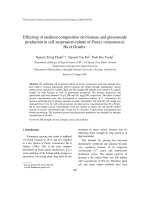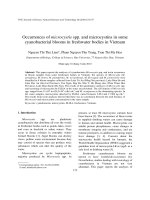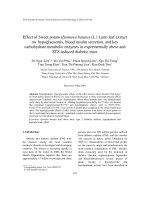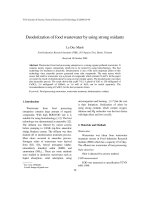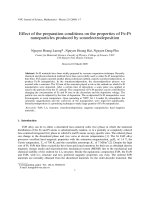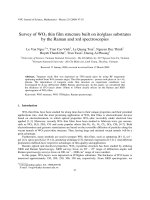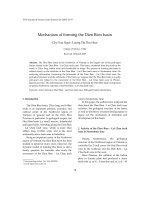Tài liệu Báo cáo " Occurrences of microcystis spp. and microcystins in some cyanobacterial blooms in freshwater bodies in Vietnam " docx
Bạn đang xem bản rút gọn của tài liệu. Xem và tải ngay bản đầy đủ của tài liệu tại đây (117.04 KB, 6 trang )
VNU Journal of Science, Natural Sciences and Technology 26 (2010) 172-177
172
Occurrences of microcystis spp. and microcystins in some
cyanobacterial blooms in freshwater bodies in Vietnam
Nguyen Thi Thu Lien*, Pham Nguyen Thu Trang, Tran Thi My Hoa
Department of Biology, College of Sciences, Hue University, 77 Nguyen Hue, Hue, Vietnam
Nhận ngày 16 tháng 3 năm 2010
Abstract. This paper reports the analyses of cyanobacteria Microcystis spp. and toxin occurrence
in bloom samples from some freshwater bodies in Vietnam. Six species of Microcystis (M.
aeruginosa, M. botrys, M. panniformis, M. wessenbergii, M. flos-aquae and M. protocystis) were
identified in 8 bloom samples collected from Lake Tri An (Đồng Nai province), Lake Bien Ho and
Lake Duc An (Gia Lai Province), Cua Ngan, Dap Da, Nhu Y, Ho Mung sites (Thua Thien Hue
Province), Lake Hoan Kiem (Ha Noi). The results of the quantitative analyses of Microcystis spp.
and screening of microcystin by ELISA in the water are presented. The cell density of Microcystis
spp. ranged from 11x10
3
to 624,5x10
3
cells/ mL
1
and M. aeruginosa as the dominating species. In
the water samples, microcystins detected by ELISA varied between 5.854 and 17.966 ng mL
-1
.
The results from toxin analyses showed that there was no correlation between the total biomass of
Microcystis and microcystins concentration in the same sample.
Keywords: cyanobacteria, microcystins, ELISA, freshwaters, Vietnam.
1. Introduction
∗
∗∗
∗
Microcystis spp. are planktonic
cyanobacteria that distribute all over the world,
in freshwater bodies such as ponds, lakes, rivers
and even in brackish or saline waters. They
occur in dense colonies in eutrophic waters
formed blooms [1]. Algal blooms can destroy
views, pollute water environment because they
may consist of species that can produce toxic
substances which can alter the quality of the
water.
Microcystins are cyclic heptapeptides,
majority produced by Microcystis spp. At
_______
∗
Corresponding author. Tel.: 84-054-832665.
E-mail:
present, at least 80 microcystin variants have
been known [2]. The occurrence of these toxins
in supplied drinking waters can cause damage
to human and animal health. Microcystins can
inhibit protein phosphatases, cause changes in
membrane integrity and conductance, and are
tumour promoters, in addition to causing major
liver damage [3, 4]. Concern about the
microcystin health hazard for humans, the
World Health Organization (WHO) suggested a
guideline level of microcystin-LR at 1µg/L as a
safe level in drinking water [5].
Freshwater cyanobacteria blooms are
known to have worldwide-occurrence [6].
Nevertheless, studies dealing with toxicology of
cyanobacteria in Vietnam are not very
abundant. This paper reports the analyses of
N.T.T. Lien et al. / VNU Journal of Science, Natural Sciences and Technology 26 (2010) 172-177
173
cyanobacteria and toxin occurrence in bloom
samples from some freshwater bodies in
Vietnam. The toxin contents were determined
by ELISA. These results will be the basic
knowledge for future studies of potential
polluted these toxins in studied area.
2. Materials and methods
Sampling sites: Bloom samples were
randomly collected from Lake Tri An (Dong
Nai province), Lake Bien Ho and Lake Duc An
(Gia Lai Province), Cua Ngan, Dap Da, Nhu Y,
Ho Mung sites (Thua Thien Hue Province),
Lake Hoan Kiem (Ha Noi). Sampling was
carried out on August 20-30, 2008.
Sampling: Qualitative samples were
collected by a plankton net and fixed by formal
4% solution. Quantitative samples were
collected by a plastic tube, 2 m in length and 10
cm in diameter. Water samples then were mixed
in a small bucket. Then the sub-samples of 100
mL were collected and fixed by Lugol acid
solution. The ones of 1.5 mL were collected in
Eppendorf tubes and were kept at -18 ºC for
toxin analysis.
Examination of samples: Both live and
preserved cyanobacterial samples were
examined by light microscopes Olympus BX60
and Olympus DP12 with digital camera.
Species were identified and taken photograph.
The identification of cyanobacterial species was
mainly made with reference to Komárek and
Anagnostidis (1999) [7, 8].
Cell counts: direct counts of preserved
samples were carried out with Sedgewick
Rafter chambers using microscope at 200 x
magnification. The Microcystis spp. colonies
were separated by sonicating in 3 minutes
before sediment in chambers.
Microcystins were analyzed by Enzyme -
Linked Immunoabsorbent Assay (ELISA) [9]:
Microcystin concentrations in bloom samples
were analyzed by the ELISA test using
Microcystins Plate Kits (Abraxis, USA). The
kits were calibrated with a non-toxic
microcystin-LR surrogate at levels equivalent to
0.1, 0.4, and 1.6 parts per billion (ppb) (or µg L
-
1
) microcystin-LR. The water samples were
sonicated for 3 minutes to lyse the cells,
followed by centrifugation for 10 min at 10 000
g. The optical density of the supernatant was
measured at 450 nm on a Microreader
(Hyperion 3) and the microcystins
concentrations (µg L
-1
) in the samples were
determined from the standard competitive curve
of microcystin-LR. If the microcystin
concentrations in the samples were higher than
levels equivalent to the standard calibration (1.6
µg L
-1
) the samples were diluted until inside the
range of the standard curve.
3. Results and discussion
Species composition of microcystis spp. in study
waters
In 8 natural bloom samples collected, we
identified six species of Microcystis including
M. aeruginosa, M. botrys, M. wesenbergii, M.
flos-aquae, M. panniformis and M. protocystis.
Species composition and their occurrences in
the studied sites were shown in Table 1.
The species M. aeruginosa, M. botrys and
M. wesenbergii were common in all studied
sites. They are tropical and subtropical bloom-
forming species. M. panniformis is tropical
species found in all sites except Tri An and
Hoan Kiem. M. flos-aquae and M. protocystis
were rare in these materials.
N.T.T. Lien et al. / VNU Journal of Science, Natural Sciences and Technology 26 (2010) 172-177
174
Table 1. Species composition of Microcystis spp. and their occurrences in the studied sites
Sampling sites
Species
Tri An Bien Ho Duc An Cua Ngan Nhu Y Dap Da Ho Mung Hoan Kiem
M. aeruginosa + + + + + + + +
M. botrys + + + + + + + +
M. wesenbergii + + + + + + + +
M. flos-aquae + – – – + + – –
M. panniformis – + + + + + + –
M. protocystis – – – + – – – –
Abbreviations: (+) present; (-) not present.
Microcystis biomasses
The results of quantitative analyses of each
species and total biomass of 8 bloom samples
collected from studies sited from 20-30
Autumn, 2008 were shown in Table 2 and Fig.
1. From Table 2, we found that the biomass of
M. aeruginosa is the highest in all samples,
especially in Nhu Y site with the cells density
of 312x10
3
cells/ mL; then M. botrys, with the
cells density of 160,5x10
3
cells/ mL in Nhu Y
site. These two species were known can
produce microcystins with high concentrations
and cause dense blooms in all studied sites. The
least amount of M. protocystis cells was found
in samples collected in Cua Ngan site with only
1x10
3
cells/ mL. This is also the toxic species
with high concentration.
Table 2. Cell density of cyanobacteria in the studied localities
Cell density (x 10
3
cells/mL)
Species
Tri
An
Bien
Ho
Duc
An
Cua
Ngan
Dap
Da
Nhu
Y
Ho
Mung
Hoan
Kiem
M. aeruginosa 108 4,5 10 29 66 312 145 7
M. botrys 10 5 13 151 131 160,5 51,6 7
M. wesenbergii 16 1 3 0,8 4,5 1 1 9
M. flos-aquae 10 0 0 0 11 10,5 0 0
M. panniformis 0 0,5 3,7 96,8 1 140,5 9,6 0
M. protocystis 0 0 0 1 0 0 0 0
Total biomasses of
Microcystis spp.
144 11 29,7 278,6 213,5 624,5 207,2 23
0
100000
200000
300000
400000
500000
600000
700000
Tri An Bien Ho Duc An Cua Ngan Dap Da Nhu Y Ho Mung Hoan
Kiem
cells/m L
M. protocystis
M. panniformis
M. flos-aquae
M. wesenbergii
M. botrys
M. aeruginosa
Fig.1. Cell density of Microcystis spp. in the studied localities.
N.T.T. Lien et al. / VNU Journal of Science, Natural Sciences and Technology 26 (2010) 172-177
175
Microcystins analyses
The results of ELISA test for microcystins
in bloom samples showed that in 8 samples of 8
studied sites, 7 samples were positive about
microcystins with rather high concentrations
(Table.3; Fig.2). Only the concentration of
toxin in Lake Tri An was too low to detect. The
toxin concentrations ranged from 17.966 ng/mL
in Duc An to 5.854 ng/mL in Nhu Y sample.
Comparing microcystin concentrations and
biomasses of Microcystis spp. (Table 3), we
found that in Duc An site, the concentration of
microcystins is highest (17.966 ng/mL) but the
biomass is rather low (29,7x10
3
cells/mL). By
contract, in Nhu Y, the concentration of
microcystins is lowest (5.854 ng/mL) but the
biomass of Microcystis spp. is highest
(624,5x10
3
cells/mL) (Table 3; Fig.2).
Table 3. Microcystins detection by ELISA in natural cyanobacterial blooms in the studied localities
Location Microcystins concentrations (ng/ mL)
Microcystis spp. biomasses
( x10
3
cells/mL)
Tri An 0 144
Bien Ho 9.434 11
Đuc An 17.966 29,7
Cua Ngan 17.579 278,6
Đap Đa 14.968 213,5
Nhu Y 5.854 624,5
Ho Mung 13.012 207,2
Hoan Kiem 16.395 23
0
100000
200000
300000
400000
500000
600000
700000
Tri An
Bien Ho
C
u
a N
gan
N
h
u Y
H
o
Mung
H
oan
K
iem
cells/mL
0
2
4
6
8
10
12
14
16
18
20
ng/mL
Microcystis spp. biomasses Microcystins concentrations (ng/ mL)
Fig.2. Microcystis biomass and microcystins concentrations in water-blooms in the studied localities.
N.T.T. Lien et al. / VNU Journal of Science, Natural Sciences and Technology 26 (2010) 172-177
176
Among six species found in this study,
M.aeruginosa, M. botrys, M. wesenbergii and
M. panniformis are the microcystin-producers
[10-14]. The species M. aeruginosa, M. botrys
and M. wesenbergii were found in all studied
sites. M. panniformis were found in Gia Lai and
Thua Thien Hue freshwaters. The non-toxic
species M. flos-aquae occurred with low
biomass in Tri An site and M. protocystis only
occurred in Cua Ngan. Thus, the microcystin
producers were abundant in all bloom samples.
However, the results from toxin analyses
showed that there was no correlation between
the total biomass of Microcystis and
microcystins concentration in the same sample.
Microcystin concentrations in waters are not
upon the total biomass but the biomass of toxin-
producers.
Although many studies demonstrated that
toxin-producing ability depend on species, in
the same species in populations of
cyanobacteria, both microcystin-producing and
non-microcystin-producing individuals may
coexist [15]. Therefore, in order to affirm
potential toxic species in freshwater, further
studies based on molecular techniques are
needed.
4. Conclusion
- The species composition in the studied
sites is seven: Microcystis aeruginosa,
Microcystis botrys, Microcystis wesenbergii,
Microcystis flos-aquae, Microcystis
panniformis, Microcystis protocystis. In these
Microcystis species, the species Microcystis
aeruginosa is abundant in all samples.
- Microcystis biomasses varied in the bloom
samples. The biomasses of M. aeruginosa and
M. botrys were rather high in the waterbodies in
Thua Thien Hue, while M. wesenbergii was
abundant in Lake Hoan Kiem and Duc An.
- The concentrations of microcystin in the
samples are high and not correlated to the
biomasses of Microcystis.
Acknowledgments
This study was supported by a research-
grant, funded by the Asia Research Center,
Vietnam National University, Hanoi.
References
[1] W. W. Carmichael, M. J. Yu, Z. R. He, J. W. He,
J.L. Yu, Occurrence of the toxic cyanobacterium
(blue-green alga) Microcystis aeruginosa in
central China. Arch. Hydrobiol 114 (1988) 21.
[2] I. Chorus, J. Bartram, Toxic Cyanobacteria in
Water, E&FN Spon, London, 1999.
[3] A.G. Codd, Cyanobacterial toxins, the
perception of water quality, and the prioritisation
of eutrophication control., Ecological
Engineering 16(1) (2000) 51.
[4] I.R. Falconer, An overview of problems caused
by toxic blue-green algae (Cyanobacteria) in
drinking and recreational water Environ.
Toxicol. 14 (1998) 5.
[5] WHO, Guidelines for drinking-water quality,
Second edition, Addendum to Volume 2 Health
criteria and other supported information World
Health Organisation, Geneva, 1996.
[6] A.G. Codd, L.F. Morrison, J.S. Metcalf,
Cyanobacterial toxins: risk management for
health protection. - Toxicol. Appl. Pharmacol.
203 (2005) 264.
[7] J. Komárek, K. Anagnostidis, Cyanoprokaryota,
1.Teil, Chroococcales. - In: Ettl, H., G. Gärtner,
H. Heynig & D. Mollenhauer (eds.):
Süsswasserflora von Mitteleuropa 19/1. Fischer
Verl., Jena/Stuttgart/Lübeck/Ulm., 1999, 548 pp.
[8] J. Komárek, J.L. Komárková, Review of the
European Microcystis-morphospecies
(Cyanoprokaryotes) from mature. Czech
Phycology, Olomouc 2 (2002) 1.
[9] Y. Uneo, S. Nagata., T. Tsutsumi., A.
Hasegawa., M. F. Watanabe ., H. H. Park., G. C.
Chen., G. Chen & S. Z. Yu: Detection of
microcystins, a blue-green algal hepatotoxin, in
drinking water sampled in Hainen and Fusui,
N.T.T. Lien et al. / VNU Journal of Science, Natural Sciences and Technology 26 (2010) 172-177
177
endemic areas of primary liver cancer in China,
by highly sensitive immunoassay.
Carcinogenesis 17: (1996) 1317.
[10] Bittencourt-Oliveira, M.C., P. Kujbida, K.H.M.
Cardozo, V.M. Carvalho, A.N. Moura, P.
Colepicolo & E. Pinto A novel rhythm of
microcystin biosynthesis is described in the
cyanobacterium Microcystis panniformis
Komárek et al., Biochem. Biophys. Res.
Commun. 326 (2005) 687.
[11] W.W. Carmichael, The toxins of cyanobacteria.,
Sci. Amer. 270 (1994) 64.
[12] P. Henriksen, Microcystin profiles and contents
in Danish populations of cyanobacteria/blue-
green algae as determined by HPLC
Phycologia 35 (1996) 102.
[13] L. Via-Ordorika, J. Fastner, R. Kurmayer, M.
Hisbergues, E. Dittmann, J. Komárek, M.
Erhard, I. Chorus Distribution of microcystin-
producing and non-microcystin producing
Microcystis sp. in European freshwater bodies:
detection of microcystins and microcystin genes
in individual colonies., Syst. Appl. Microbiol. 27
(2004) 592.
[14] T.T.L. Nguyen, G. Cronberg, H. Annadotter, J.
Larsen: Planktic cyanobacteria from freshwater
localities in Thuathien-Hue province, Vietnam.
II. Algal biomass and microcystin production. -
Nova Hedwigia 85(2007) 35.
[15] R. Kurmayer, G. Christiansen, J. Fastner, T.
Börner, Abundance of active and inactive
microcystin genotypes in populations of the
toxic cyanobacterium Planktothrix spp. -
Environ. Microbiol. 6(2004) 831.
Sự hiện diện của các loài vi khuẩn lam ñộc hại
microcystis spp. và ñộc tố microcystin trong một số
thủy vực nở hoa ở Việt Nam
Nguyễn Thị Thu Liên, Phạm Nguyễn Thu Trang, Trần Thị Mỹ Hoa
Khoa Sinh học, Trường Đại học Khoa học, Đại học Huế, 77 Nguyễn Huệ, Huế, Việt Nam
Bài báo này trình bày kết quả phân tích sự hiện diện của các loài vi khuẩn lam thuộc chi
Microcystis spp. và ñộc tố của chúng trong những mẫu nở hoa thu từ một số thủy vực nước ngọt Việt
Nam. Sáu loài Microcystis ñã ñược xác ñịnh trong 8 mẫu nước thu từ hồ Trị An (tỉnh Đồng Nai), Biển
Hồ, hồ Đức An (tỉnh Gia Lai), các ñiểm Cửa Ngăn, Như Ý, Đập Đá, Hồ Mưng (tỉnh Thừa Thiên Huế),
hồ Hoàn Kiếm (Hà Nội). Kết quả phân tích ñịnh lượng tế bào của các loài Microcystis và ñộc tố
microcystin trong nước bằng kỹ thuật ELISA cũng ñược trình bày. Mật ñộ tế bào dao ñộng trong
khoảng từ 11x10
3
ñến 624,5x10
3
tế bào mL
-1
và loài ưu thế là M. aeruginosa. Trong các mẫu nước,
hàm lượng microcystin ñược thăm dò biến ñộng trong khoảng từ 5,854 ñến 17,966 ng mL
-1
. Kết quả
phân tích cho thấy không có mối liên quan giữa tổng sinh khối của các loài Microcystis và nồng ñộ
microcystin trong cùng một mẫu nghiên cứu.

